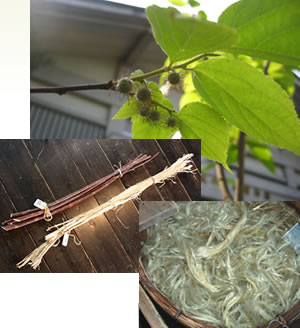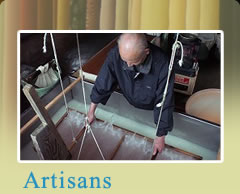Types of natural material for Echizen Washi

Kozo Leaf
Japanese paper, washi, is made from three main materials, such as kozo ( mulberry ), mitsumata and gampi. The bark of each kind is used for making Japanese paper after the long processes to take out of its fiber. In Echizen, people who plant kozo or mitsumata are getting less and less because most of the papermakers here use imported materials for much lower cost. I heard my boss's father grew mitsumata and I've seen the traces in the backyard of the mountain. And someone once told me there were wild gampis around here but they are rarely seen now.
But some papermakers here, such as Ichibei Iwano and Shohachi Yamaguchi, of course, try to use pure Japanese materials because the quality of paper can be very good.
Except for those three main materials, we also use hemp, bamboo, wood pulp etc.
Kozo:It grows more than three meter high in a year and it's cultivated every year fall. Before I came here my image for paper was "destruction of nature ", which sounds strange now after I learned kozo grows fast and its one big root keeps growing new branches one after another every year.
Its long and thick fiber creates strong paper. Major areas of production are in Kochi and Ibaragi prefectures. Traditionally kozo has been used for hosho paper and the paper for woodblock printing, ink painting and calligraphy. Nowadays it is also used for a wide variety of Japanese paper methods including paper dolls and craftworks.
Mitsumata: Literally the name comes from its feature of the branch, "forking into three", in Japanese. It takes three years to become about two meter high to be used for papermaking. Its fiber is shorter and weaker than that of kozo, but creates smooth and glossy surface. Mitsumata is used for fusuma, paper door, and is also used as some designs on paper.
Gampi: It is difficult to cultivate gampi, so wild one is collected. It has long been used for papermaking in Japan. Its fine fiber creates thin paper with strong luster. Because gampi is relatively resistant to insects, it is used for paper that requires high keeping quality. I heard Gampi is very expensive, so that mitsumata sometimes can be used for its alternative method because of the similar qualities. But still gampi paper is very beautiful.
Hemp: It has been used since old times because of its high keeping quality similar to that of gampi. You cannot make a good paper using only hemp. But the combination of hemp and kozo or the other materials creates strong paper. After the WW2 cultivating hemp became widely forbidden in Japan, so hemp from Manila is used frequently here now.
Wood pulp: It is the cheapest material but its fiber is very short and the paper made only from wood pulp is very weak.
Types and usage of Echizen Washi

Hosho
The followings are major categories in Echizen Washi.
Hosho: kizuki-hosho, otaka-danshi
Used for woodblock printing, wrapping paper for traditional ceremony gifts, certificate paper etc.
Gasenshi (drawing paper): gasenshi, gashi
Used for calligraphy, drawing, Japanese style painting, copying sutras ( called shyakyo in Japanese ) etc.
Torinoko:
Used for fusuma ( paper door ), wall paper, folding screen, woodblock printing, card, diploma etc.
Koma-gami: komagami for art and crafts paper
Used for sake ( Japanese alcohol made from rince ) label, post card, letter paper, envelope, brochure, wrapping paper, umbrella paper etc. Brand names can be printed on those papers.
Kyokushi:
Used for certificates, diploma, name card, post card, watercolor painting etc.
Here in Echizen, we produce various kinds of paper from small name card to the one for the largest painting in the world. Also, we accept any challenging paper orders with our special techniques. New or creative ideas are always welcome!










